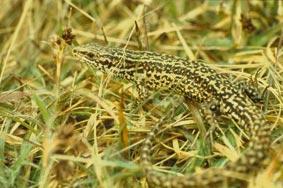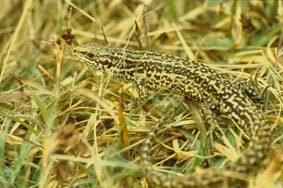The one St Patrick forgot

If our patron saint really did drive out the reptiles, he left one important one behind. Éanna Ní Lamhna on Ireland's native viviparous lizard
I received a query the other day from a very well-travelled correspondent, who reported encountering a dead gecko on the roadside in Co Fermanagh. He knew it was a gecko because he had seen such things in warmer climes – green, four legs, a tail and scaly skin. But how could such a thing have arrived in Fermanagh and bred here?
Of course, the answer is, it couldn't and it didn't. It was not a gecko, which lives in countries much further south with much warmer winters than Ireland's, but a viviparous lizard, which arrived in Ireland under its own steam after the Ice Age and has been native here ever since. 'Viviparous' is the Latin for 'giving birth to live young'. This is the key to the survival of reptiles at these northern climes.
In general, reptiles lay eggs. They are buried in warm sand and hatch out in the fullness of time on their own with no mammies present. In Ireland, however, it is too cold for such a lifestyle so there is a noticeable absence of snakes, turtles and Komodo dragons about. Such a gap in our animal fauna has always been attributed to the machinations of St Patrick, who drove these loathsome creatures from our shores. Why no other bringers of Christianity were endowed with such skills is perplexing. Why was no missionary to Africa or the Far East endowed with such skills? Why only Ireland? I think there should be an enquiry. Then again, maybe not – after all, St Patrick didn't do a thorough job. We still have a native species of reptile here, even if it's not a snake.
Ireland's native lizard cannot lay eggs, but gives birth to live young. But only mammals give birth to live young, so what's going on here?
Lizards of other species form their young in eggs which are laid and hatched outside the body of the mother.
However, our species of lizard holds on to the eggs inside her body, where they develop in their shell until they are ready to hatch. In this situation, their "shell" is merely a thin, transparent membrane which is broken from the inside by the baby lizard shortly after birth – within a few minutes – hence viviparous or live birth.
But of course the process is nothing similar to that in mammals – no placenta, no feeding of the young with milk by the mother and certainly no loving maternal care. The lizard has merely been acting as a warm place for the eggs to hatch and really has no interest in the young that she gives birth to. They have to forage for themselves from the word go.
But as a consequence of this live-birth method, they can live in colder climates and hide from crusading saints with crosiers.
